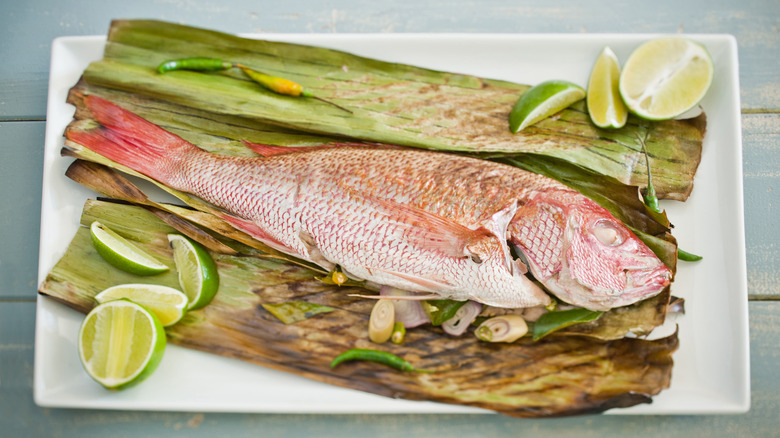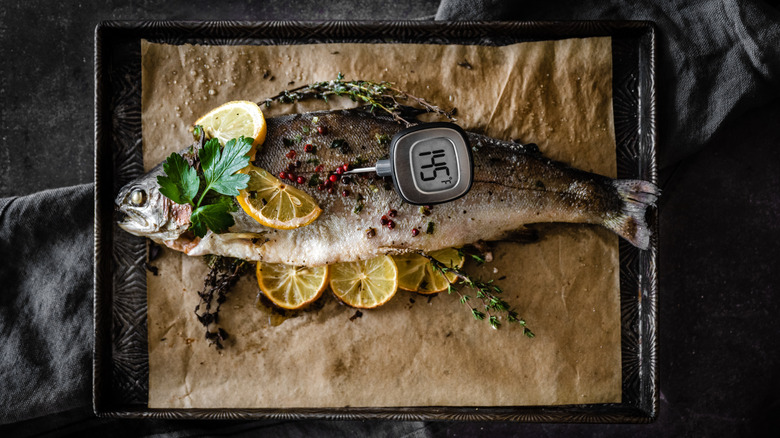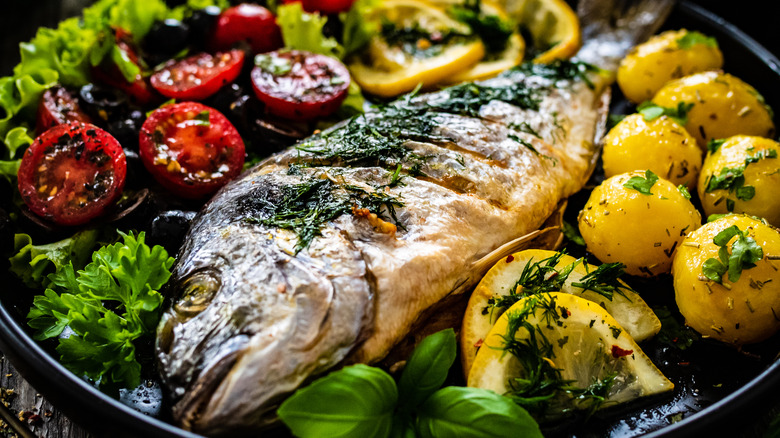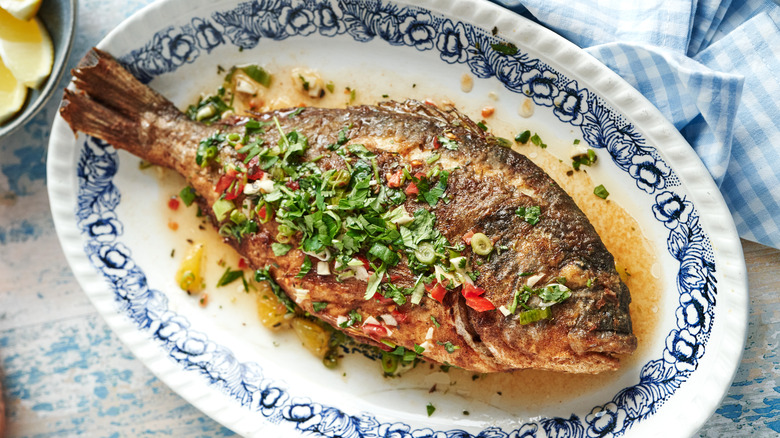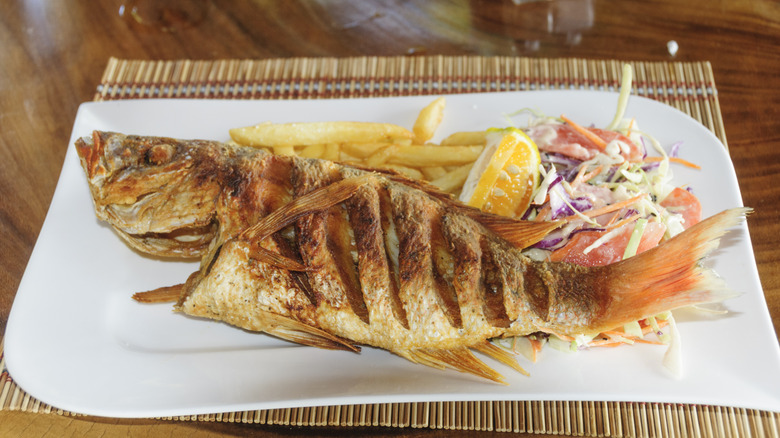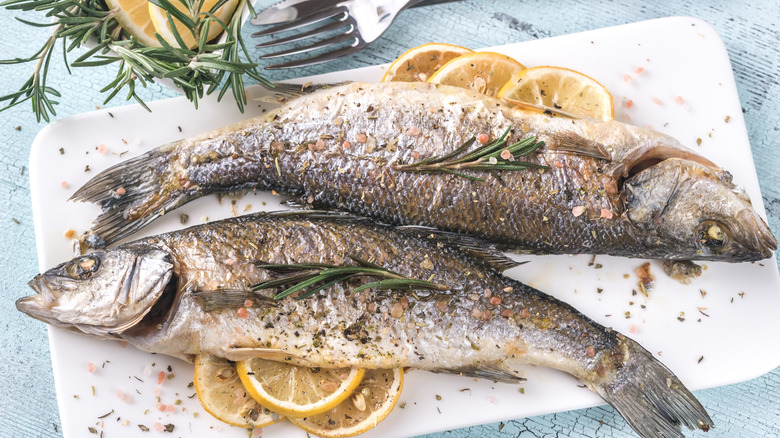How To Eat A Whole Fish Like A True Food Connoisseur
It may not be commonplace in the United States, but in countries like China, Italy, Thailand, and more, serving and eating a whole fish is a culinary tradition, and for good reason. Cooking the entirety of the aquatic animal gives you access to some of its most succulent parts and lets you be more intentional with your diet. Shelley Edmundson, the executive director of the Martha's Vineyard Fishermen's Preservation Trust, told Martha's Vineyard Magazine that eating whole fish "makes you more connected to the beauty of what you are eating." In this way, you can gain a better appreciation for the texture, flavor, and quality of a freshly caught fish.
Cooking the whole fish is considered nose-to-tail eating, a practice that encourages reducing waste by consuming as much of an animal as possible. It's also become a bit of a trend in the restaurant world, which makes sense since it's the perfect show-stopping dish for a group of people. The idea of eating the animal whole might seem a bit daunting to those who are used to filets, but it's definitely worth the effort. All you need is a bit of know-how and you'll be chowing down on fresh fish in no time (and if something just isn't appetizing to you, don't force yourself to enjoy it).
Picking and presenting the fish
Whether you plan on dining out or eating at home, the first step on your journey is to pick what type of fish you want to eat (if you're cooking, make sure to check out our tips on grilling an incredible fish dinner). Theoretically, pretty much any variety can be enjoyed whole. We'll be focusing on some of the most popular options like red snapper, mahi mahi, and sea bass. But if you want to take out some of the prep work, small fish like smelt and sardines can actually be cooked and eaten whole — bones and all.
If you're serving the fish yourself, choose a large platter that will leave plenty of room once people start to pick the meat apart. You may also want to choose a dish with a raised edge to catch all the juice and bones. A whole cooked fish is already a stunning sight, but you can dress the platter up even more with lemon wedges or fresh herbs like basil and parsley. Eating whole fish is typically a communal experience, so while you can pass out small plates to your guests, you can also encourage everyone to eat straight from the platter.
Digging in
As far as utensils go, you can use chopsticks, a fork and knife, or even your hands as long as they're clean. If you're serving a group, you may want to keep a larger carving knife on the platter so that guests can cut off bigger chunks of the meat for themselves. Handling whole fish can make some people a bit squeamish if they're not used to it, but there's really nothing to be worried about. Feel free to move the meat about as much as you need to get the piece you want.
Cooked fish has already been cleaned and gutted, which means that everything left on the plate is edible (with the exception of large bones). That includes one of the most flavorful parts of the fish: the skin. Depending on how it was cooked and seasoned, it can be a delightfully crispy contrast to the rest of the tender meat. In fact, one chef thinks it's the best part of the fish. If that sounds good to you, look for whole fish recipes that involve direct heating methods like roasting or grilling. Sometimes, the skin may come out a bit softer. While the texture may not be as satisfying, it can still hold a lot of seasoning and is a good source of nutrients like vitamin E.
Beware of the bones
There's no "right place" to take your first bite out of a whole fish, but if you're new to the practice, you may want to start with the filet. This succulent meat can be found between the collar and tail of the animal on either side. Use your utensils to pierce the skin and dig in, but beware of bones. Fish bones, specifically their ribs, are long, thin, and become nearly translucent when cooked. The main downside of eating whole fish is having to avoid these pieces, but with a bit of mindfulness, it's not too hard. Take small, deliberate bites, and make sure to examine each one. Being intentional in this way is part of the appeal of whole fish: It forces you to take your time and really experience the flavors.
If you do spy a bone, use your fingers to remove it and throw it away. To keep things a bit tidier, you may want to keep an empty bowl next to the fish platter to act as a trash bin. In the unfortunate case that you swallow a fish bone, remain calm. In most cases, drinking water and coughing can dislodge it. Healthline says you can also try eating sticky marshmallows.
Eating the cheeks and collar
Many believe that the best parts of a fish are its cheeks and collar. They're often overlooked in modern American cooking, and eating the whole animal is a great opportunity to try these sections. The cheeks, located just below the eyes, are particularly prized for their tenderness and sweet flavor. Use a small spoon or knife to scoop out the flesh gently, working along the bone from behind the eye to above the lip (you may have to use a bit of force to get past some of the bone). The cheek meat is smooth and buttery, similar to a scallop. There's only two on every fish, so try it out and make sure to savor the experience.
Another favorite of fish lovers is the collar. This cut is located between the head and the filet, and is beloved for its rich umami flavor. The collar meat is boneless and super tender, so you can dig in without fear. It's also an affordable cut for the days when you don't feel like eating an entire fish. You can usually find one from your local fishmonger for pretty cheap. From there, all you have to do is toss it on the grill or broil it. Just be sure to avoid the usual mistakes people make when cooking fish.
Fish eyes and tails
If you're not used to eating whole fish, the eyes and tail and probably the most intimidating parts. Don't be scared, though: These sections contain a ton of protein and healthy fatty acids and provide a unique range of flavors and textures. Fish eyes especially are considered a delicacy in many cultures, and each one is usually eaten in a single bite. They're gummy by nature, but if cooked right they can have nice crunchy crusts that serve as a nice contrast. Either way, fish eyes are packed with intense umami. Fish tails are also super flavorful, and frying or roasting them can give them a crisp, flakey texture similar to a potato chip. People usually eat tail and fin meat with their hands.
The especially adventurous can even throw together some nice side dishes. The tail, for example, makes a great centerpiece for a tasty soup. Brace yourself for this one: The eyes can even be squeezed for their gel, which can be used as a flavoring and thickener for your soup.
